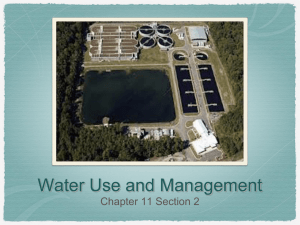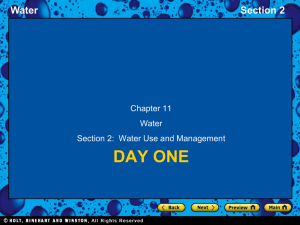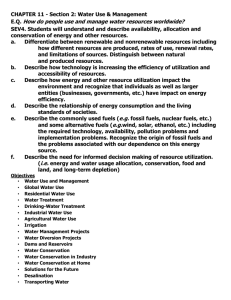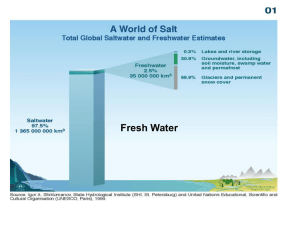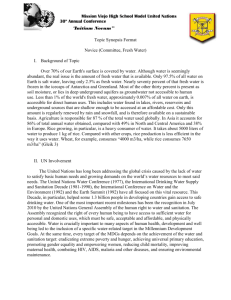Name: Chapter 5: Water NOTES Ch. 5, Section 5.2: Water Use and
advertisement
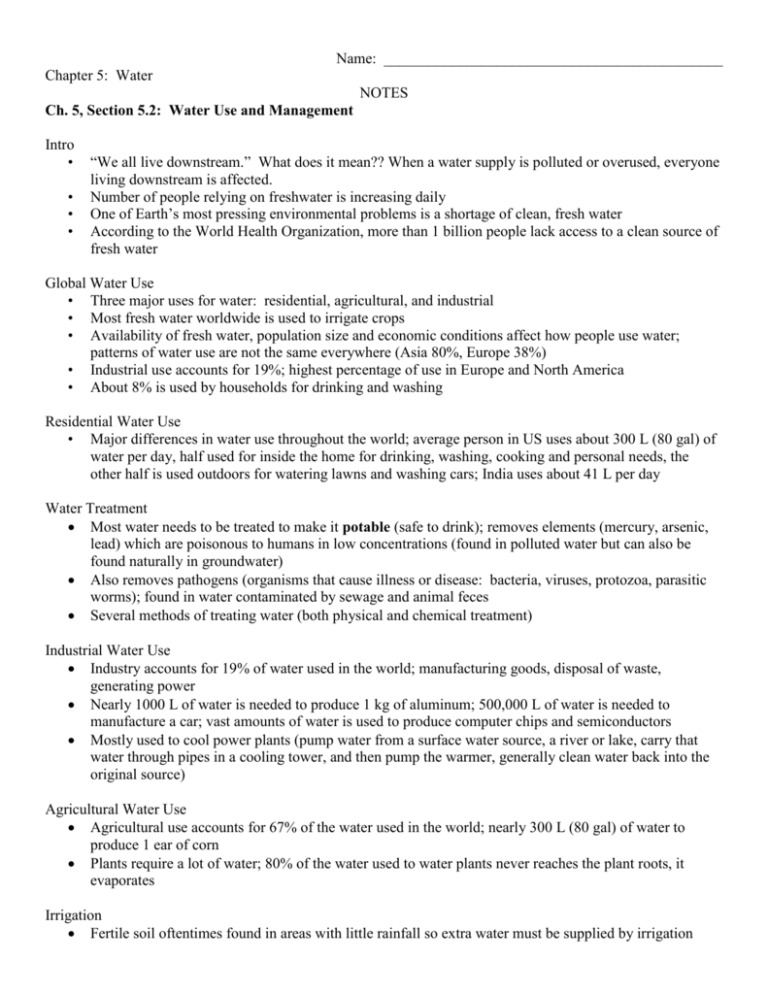
Name: _____________________________________________ Chapter 5: Water NOTES Ch. 5, Section 5.2: Water Use and Management Intro • • • • “We all live downstream.” What does it mean?? When a water supply is polluted or overused, everyone living downstream is affected. Number of people relying on freshwater is increasing daily One of Earth’s most pressing environmental problems is a shortage of clean, fresh water According to the World Health Organization, more than 1 billion people lack access to a clean source of fresh water Global Water Use • Three major uses for water: residential, agricultural, and industrial • Most fresh water worldwide is used to irrigate crops • Availability of fresh water, population size and economic conditions affect how people use water; patterns of water use are not the same everywhere (Asia 80%, Europe 38%) • Industrial use accounts for 19%; highest percentage of use in Europe and North America • About 8% is used by households for drinking and washing Residential Water Use • Major differences in water use throughout the world; average person in US uses about 300 L (80 gal) of water per day, half used for inside the home for drinking, washing, cooking and personal needs, the other half is used outdoors for watering lawns and washing cars; India uses about 41 L per day Water Treatment Most water needs to be treated to make it potable (safe to drink); removes elements (mercury, arsenic, lead) which are poisonous to humans in low concentrations (found in polluted water but can also be found naturally in groundwater) Also removes pathogens (organisms that cause illness or disease: bacteria, viruses, protozoa, parasitic worms); found in water contaminated by sewage and animal feces Several methods of treating water (both physical and chemical treatment) Industrial Water Use Industry accounts for 19% of water used in the world; manufacturing goods, disposal of waste, generating power Nearly 1000 L of water is needed to produce 1 kg of aluminum; 500,000 L of water is needed to manufacture a car; vast amounts of water is used to produce computer chips and semiconductors Mostly used to cool power plants (pump water from a surface water source, a river or lake, carry that water through pipes in a cooling tower, and then pump the warmer, generally clean water back into the original source) Agricultural Water Use Agricultural use accounts for 67% of the water used in the world; nearly 300 L (80 gal) of water to produce 1 ear of corn Plants require a lot of water; 80% of the water used to water plants never reaches the plant roots, it evaporates Irrigation Fertile soil oftentimes found in areas with little rainfall so extra water must be supplied by irrigation Irrigation is a method used to provide plants with water from sources other than direct precipitation (earliest forms of irrigation involved flooding the fields) Many forms of irrigation are used today, ex: shallow, water-filled ditches (cotton), high pressure overhead sprinklers (inefficient because nearly ½ evaporates and never reaches roots Newer, more efficient methods are becoming more common Waste Management Projects For thousands of years, humans have altered streams and rivers to make them more useful Nearly 2000 years ago, Romans built aqueducts (huge canals from mountains to dry areas); some are still used today; today, modern engineering has allowed water projects to become more complex Water management projects (dams and water diversion canals) allow people to live in desirable areas where surface water is inadequate, or to create reservoirs for recreation or drinking water, and to generate electric power Piped in water allows people to live and grow crops in Southwest US (desert areas) Water Diversion Projects All or parts of rivers can be diverted into canals to provide water to dry regions, ex: Owens River in California provides drinking water to Los Angeles; Colorado River provides water to 7 states Colorado River (flows 1450 miles) begins as a glacial stream in the Rocky Mountains, grows larger as of the streams feed into it; then divided to meet the needs of the states; so much of the water is diverted for irrigation and drinking water that it runs dry before it ever reaches Mexico and the Gulf of California (only makes it there in the wettest years) River water is in high demand; disputes over who have rights to it occur often (ex: Colorado River) 40% of world’s people rely on water that originates in another country; conflicts over water rights, especially when dams are built restricting flow to other countries downstream are common Disputes over water rights is likely to become more common as populations increase and demand for fresh water increases Dams and Reservoirs • Structures built across a river to restrict the flow of water downstream and form a reservoir (artificial lake formed behind the dam) • Water is used for drinking, irrigation, manufacturing, flood control, electricity and recreation • Hydroelectric dams use the power of flowing water to turn a turbine that generates electrical energy; about 20% of the world’s electricity is generated by hydroelectric energy • Mixed blessing: artificial lake destroys existing ecosystems when they are formed and disrupts ecosystems downstream when they get less water; people are displaced from their homes (close to 50 million people worldwide); farmland below a dam is affected as a result of nutrient rich sediment being blocked behind the dam rather than flowing downstream • Dams can malfunction and burst, killing many people below the dam • No additional dams being built in US but will probably continue in developing countries (Brazil, India and China) Water Conservation • As water sources become depleted, water becomes more expensive; • Water conservation is one way people will have enough water at reasonable prices Water Conservation in Agriculture • Most water loss in agriculture comes from evaporation, seepage and runoff • Drip irrigation systems offer an initial step toward conservation (deliver small amounts of water directly to plant roots by using perforated tubing, released as needed at a controlled rate); managed by computer programs; very little loss of water to evaporation, seepage or runoff Water Conservation in Industry • Industries have developed water conservation plans due to the rising cost for water • Most conservation practices involve recycling of cooling water and wastewater; instead of returning water to rivers, businesses recycle the water and reuse it (ex: production of paper uses less than 30% of the water required to produce the same amount of paper as 50 years ago) • In Denver, Colorado, the city pays small businesses to introduce water conservation methods; saves money for the city and the businesses and makes more water available for agriculture and residential use. Water Conservation at Home • Households use much less water than agriculture and industry, however, people can make a difference by changing a few everyday habits (using low flow toilets and shower heads, water lawns at night, take shorter showers don't run water while brushing your teeth, wash only full loads of laundry and dishes) • Xeriscaping - designing landscapes that require minimal water use Solutions for the Future • Conservation alone is not enough to prevent water shortages, other sources of fresh water needs to be developed • Two possible solutions: Desalination and transporting fresh water Desalination • Desalination is the process of removing salt from saltwater; desalination plants heat salt water and collect the fresh water that evaporates • Some coastal communities rely on the oceans to provide fresh water and have built desalination plants (Middle East) • Desalination consumes a lot of energy, the process is too expensive for many nations to consider Transporting Water • In areas where freshwater resources are not adequate, water can be transported from other regions (ex: Greece, high tourist area, not enough fresh water to handle residents and tourists so large ships towing enormous plastic bags of water travel regularly to the Greek Islands to pump fresh water) • This is a solution the US is considering, too. (Alaska has 1/2 the available fresh water; tow Alaskan water down the Californian coast) • With 76% of Earth's fresh water in frozen icecaps, people have considered towing icebergs to communities needing fresh water; however, efficient ways to tow the icebergs is yet to be discovered
